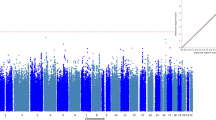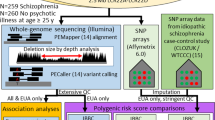Abstract
Several lines of evidence have implicated the catechol-O-methyltransferase (COMT) gene as a candidate for schizophrenia (SZ) susceptibility, not only because it encodes a key dopamine catabolic enzyme but also because it maps to the velocardiofacial syndrome region of chromosome 22q11 which has long been associated with SZ predisposition. The interest in COMT as a candidate SZ risk factor has led to numerous case–control and family-based studies, with the majority placing emphasis on examining a functional Val/Met polymorphism within this enzyme. Unfortunately, these studies have continually produced conflicting results. To assess the genetic contribution of other COMT variants to SZ susceptibility, we investigated three single-nucleotide polymorphisms (SNPs) (rs737865, rs4633, rs165599) in addition to the Val/Met variant (rs4680) in a highly selected sample of Australian Caucasian families containing 107 patients with SZ. The Val/Met and rs4633 variants showed nominally significant associations with SZ (P<0.05), although neither of the individual SNPs remained significant after adjusting for multiple testing (most significant P=0.1174). However, haplotype analyses showed strong evidence of an association; the most significant being the three-marker haplotype rs737865-rs4680-rs165599 (global P=0.0022), which spans more than 26 kb. Importantly, conditional analyses indicated the presence of two separate and interacting effects within this haplotype, irrespective of gender. In addition, our results indicate the Val/Met polymorphism is not disease-causing and is simply in strong linkage disequilibrium with a causative effect, which interacts with another as yet unidentified variant ∼20 kb away. These results may help explain the inconsistent results reported on the Val/Met polymorphism and have important implications for future investigations into the role of COMT in SZ susceptibility.
This is a preview of subscription content, access via your institution
Access options
Subscribe to this journal
Receive 12 print issues and online access
$259.00 per year
only $21.58 per issue
Buy this article
- Purchase on Springer Link
- Instant access to full article PDF
Prices may be subject to local taxes which are calculated during checkout
Similar content being viewed by others
References
Pulver AE, Nestadt G, Goldberg R, Shprintzen RJ, Lamacz M, Wolyniec PS et al. Psychotic illness in patients diagnosed with velo-cardio-facial syndrome and their relatives. J Nerv Ment Dis 1994; 182: 476–478.
Murphy KC, Jones LA, Owen MJ . High rates of schizophrenia in adults with velo-cardio-facial syndrome. Arch Gen Psychiatry 1999; 56: 940–945.
Ivanov D, Kirov G, Norton N, Williams HJ, Williams NM, Nikolov I et al. Chromosome 22q11 deletions, velo-cardio-facial syndrome and early-onset psychosis. Molecular genetic study. Br J Psychiatry 2003; 183: 409–413.
Lindsay EA, Goldberg R, Jurecic V, Morrow B, Carlson C, Kucherlapati RS et al. Velo-cardio-facial syndrome: frequency and extent of 22q11 deletions. Am J Med Genet 1995; 57: 514–522.
Lewis CM, Levinson DF, Wise LH, DeLisi LE, Straub RE, Hovatta I et al. Genome scan meta-analysis of schizophrenia and bipolar disorder, part II: Schizophrenia. Am J Hum Genet 2003; 73: 34–48.
Badner JA, Gershon ES . Meta-analysis of whole-genome linkage scans of bipolar disorder and schizophrenia. Mol psychiatry 2002; 7: 405–411.
Lotta T, Vidgren J, Tilgmann C, Ulmanen I, Melen K, Julkunen I et al. Kinetics of human soluble and membrane-bound catechol O-methyltransferase: a revised mechanism and description of the thermolabile variant of the enzyme. Biochemistry 1995; 34: 4202–4210.
Shield AJ, Thomae BA, Eckloff BW, Wieben ED, Weinshilboum RM . Human catechol O-methyltransferase genetic variation: gene resequencing and functional characterization of variant allozymes. Mol Psychiatry 2004; 9: 151–160.
Lachman HM, Papolos DF, Saito T, Yu YM, Szumlanski CL, Weinshilboum RM . Human catechol-O-methyltransferase pharmacogenetics: description of a functional polymorphism and its potential application to neuropsychiatric disorders. Pharmacogenetics 1996; 6: 243–250.
Egan MF, Goldberg TE, Kolachana BS, Callicott JH, Mazzanti CM, Straub RE et al. Effect of COMT Val108/158 Met genotype on frontal lobe function and risk for schizophrenia. Proc Natl Acad Sci USA 2001; 98: 6917–6922.
Joober R, Gauthier J, Lal S, Bloom D, Lalonde P, Rouleau G et al. Catechol-O-methyltransferase Val-108/158-Met gene variants associated with performance on the Wisconsin Card Sorting Test. Arch Gen Psychiatry 2002; 59: 662–663.
Malhotra AK, Kestler LJ, Mazzanti C, Bates JA, Goldberg T, Goldman D . A functional polymorphism in the COMT gene and performance on a test of prefrontal cognition. Am J Psychiatry 2002; 159: 652–654.
Li T, Sham PC, Vallada H, Xie T, Tang X, Murray RM et al. Preferential transmission of the high activity allele of COMT in schizophrenia. Psychiatr Genet 1996; 6: 131–133.
Li T, Ball D, Zhao J, Murray RM, Liu X, Sham PC et al. Family-based linkage disequilibrium mapping using SNP marker haplotypes: application to a potential locus for schizophrenia at chromosome 22q11. Mol Psychiatry 2000; 5: 77–84.
Glatt SJ, Faraone SV, Tsuang MT . Association between a functional catechol O-methyltransferase gene polymorphism and schizophrenia: meta-analysis of case–control and family-based studies. Am J Psychiatry 2003; 160: 469–476.
Shifman S, Bronstein M, Sternfeld M, Pisante-Shalom A, Lev-Lehman E, Weizman A et al. A highly significant association between a COMT haplotype and schizophrenia. Am J Hum Genet 2002; 71: 1296–1302.
APA. Diagnostic and Statistical Manual of Mental Disorders. American Psychiatric Association: Washington, DC, 1994.
Owen MJ, O'Donovan MC, Gottesman II . Schizophrenia. In: McGuffin P, Owen MJ, Gottesman II (eds) Psychiatric Genetics and Genomics. Oxford University Press: Oxford, 2002 pp 247–266.
Levinson DF, Mowry BJ . Genetics of Schizophrenia. In: Pfaff DW, Berrettini WH, Maxson SC, Joh TH (eds) Genetic Influences on Neural and Behavioural Functions. CRC Press: New York, 2000 pp 47–82.
Nurnberger Jr JI, Blehar MC, Kaufmann CA, York-Cooler C, Simpson SG, Harkavy-Friedman J et al. Diagnostic interview for genetic studies: rationale, unique features, and training. Arch Gen Psychiatry 1994; 51: 849–859.
NIMH. Family Interview for Genetic Studies (FIGS). National Institute of Mental Health: Washington, DC, 1999.
Sun X, Ding H, Hung K, Guo B . A new MALDI-TOF based mini-sequencing assay for genotyping of SNPS. Nucleic Acids Res 2000; 28: E68.
Bray MS, Boerwinkle E, Doris PA . High-throughput multiplex SNP genotyping with MALDI-TOF mass spectrometry: practice, problems and promise. Hum Mutat 2001; 17: 296–304.
Cubells JF, Kobayashi K, Nagatsu T, Kidd KK, Kidd JR, Calafell F et al. Population genetics of a functional variant of the dopamine beta-hydroxylase gene (DBH). Am J Med Genet 1997; 74: 374–379.
Nyholt DR . A simple correction for multiple testing for single-nucleotide polymorphisms in linkage disequilibrium with each other. Am J Hum Genet 2004; 74: 765–769.
Dudbridge F . Pedigree disequilibrium tests for multilocus haplotypes. Genet Epidemiol 2003; 25: 115–121.
Terwilliger JD, Ott J . A haplotype-based ‘haplotype relative risk’ approach to detecting allelic associations. Hum Hered 1992; 42: 337–346.
Fallin D, Schork NJ . Accuracy of haplotype frequency estimation for biallelic loci, via the expectation-maximization algorithm for unphased diploid genotype data. Am J Hum Genet 2000; 67: 947–959.
Mander AP . Haplotype analysis in population-based association studies. Stata J 2001; 1: 58–75.
Agresti A, Coull BA . Approximate is better than ‘exact’ for interval estimation of binomial proportions. Am Statist 1998; 52: 119–126.
Brown LD, Cai TT, DasGupta A . Interval estimation for a binomial proportion. Statist Sci 2001; 16: 101–133.
Wilson EB . Probable inference, the law of succession, and statistical inference. J Am Statist Assoc 1927; 22: 209–212.
Clayton D . A generalization of the transmission/disequilibrium test for uncertain-haplotype transmission. Am J Hum Genet 1999; 65: 1170–1177.
Kilding R, Iles MM, Timms JM, Worthington J, Wilson AG . Additional genetic susceptibility for rheumatoid arthritis telomeric of the DRB1 locus. Arthritis Rheum 2004; 50: 763–769.
Chen X, Wang X, O'Neill AF, Walsh D, Kendler KS . Variants in the catechol-o-methyltransferase (COMT) gene are associated with schizophrenia in Irish high-density families. Mol Psychiatry, advance online publication May 4, 2004.
Tenhunen J, Salminen M, Lundstrom K, Kiviluoto T, Savolainen R, Ulmanen I . Genomic organization of the human catechol O-methyltransferase gene and its expression from two distinct promoters. Eur J Biochem 1994; 223: 1049–1059.
Bray NJ, Buckland PR, Williams NM, Williams HJ, Norton N, Owen MJ et al. A haplotype implicated in schizophrenia susceptibility is associated with reduced COMT expression in human brain. Am J Hum Genet 2003; 73: 152–161.
Palmatier MA, Pakstis AJ, Speed W, Paschou P, Goldman D, Odunsi A et al. COMT haplotypes suggest P2 promoter region relevance for schizophrenia. Mol Psychiatry 2004; 9: 859–870.
Xu Q, Jia YB, Zhang BY, Zou K, Tao YB, Wang YP et al. Association study of an SNP combination pattern in the dopaminergic pathway in paranoid schizophrenia: a novel strategy for complex disorders. Mol Psychiatry 2004; 9: 510–521.
Kunugi H, Vallada HP, Sham PC, Hoda F, Arranz MJ, Li T et al. Catechol-O-methyltransferase polymorphisms and schizophrenia: a transmission disequilibrium study in multiply affected families. Psychiatr Genet 1997; 7: 97–101.
Purcell S, Cherny SS, Sham PC . Genetic Power Calculator: design of linkage and association genetic mapping studies of complex traits. Bioinformatics 2003; 19: 149–150.
Suarez BK, Hodge SE . A simple method to detect linkage for rare recessive diseases: an application to juvenile diabetes. Clin Genet 1979; 15: 126–136.
Knapp M . A note on power approximations for the transmission/disequilibrium test. Am J Hum Genet 1999; 64: 1177–1185.
Antoniou AC, Easton DF . Polygenic inheritance of breast cancer: implications for design of association studies. Genet Epidemiol 2003; 25: 190–202.
Acknowledgements
We acknowledge the participation of individuals and family members in this work. We thank Professor David Copolov, Mental Health Research Institute, Melbourne, Professor Robert Barrett, University of Adelaide, Adelaide and Dr Elsa Bernardi, University of New South Wales, Sydney for being on-site supervisors for family recruitment. We also thank the research assistants who recruited this sample: Anna Rybak, Elizabeth Leeton, Matthew O'Brien and Linda Byrne. This research was supported by NIMH Grant R01 MH 59588. Dr Nyholt was supported by NHMRC Grant 241916.
Author information
Authors and Affiliations
Corresponding author
Additional information
Electronic-Database Information
URLs for data presented herein are as follows:
Abecasis Website, http://www.sph.umich.edu/csg/abecasis/GOLD/download/index.html (for GOLD, accessed January 30, 2003)
Genetic Power Calculator, http://statgen.iop.kcl.ac.uk/gpc/
Kidd Lab Website, http://krunch.med.yale.edu/hwsim/ (for HWSIM)
National Center for Biotechnology Information, Single Nucleotide Polymorphism Database, http://www.ncbi.nlm.nih.gov/SNP/ (for reference identification numbers for SNPs)
National Institute of Mental Health (1999) FIGS face sheet, http://zork.wustl.edu/nimh/figs/FIGS.pdf
Online Mendelian Inheritance in Man (OMIM), http://www.ncbi.nlm.nih.gov/Omim/ (for SCZD, COMT, and VCFS)
MIT Genome Centre, http://www.broad.mit.edu/ftp/distribution/software/pedmanager/ (for PEDMANAGER)
Supplementary Information accompanies the paper on Molecular Psychiatry website (http://www.nature.com/mp)
Supplementary information
Rights and permissions
About this article
Cite this article
Handoko, H., Nyholt, D., Hayward, N. et al. Separate and interacting effects within the catechol-O-methyltransferase (COMT) are associated with schizophrenia. Mol Psychiatry 10, 589–597 (2005). https://doi.org/10.1038/sj.mp.4001606
Received:
Revised:
Accepted:
Published:
Issue Date:
DOI: https://doi.org/10.1038/sj.mp.4001606
Keywords
This article is cited by
-
The Catechol-O-Methyl Transferase Val158Met Polymorphism and Experience of Reward in the Flow of Daily Life
Neuropsychopharmacology (2008)
-
Antipsychotic-induced tardive dyskinesia and polymorphic variations in COMT, DRD2, CYP1A2 and MnSOD genes: a meta-analysis of pharmacogenetic interactions
Molecular Psychiatry (2008)
-
Steroids, sex and the cerebellar cortex: implications for human disease
The Cerebellum (2008)
-
Evidence for statistical epistasis between catechol-O-methyltransferase (COMT) and polymorphisms in RGS4, G72 (DAOA), GRM3, and DISC1: influence on risk of schizophrenia
Human Genetics (2007)
-
A linkage and family-based association analysis of a potential neurocognitive endophenotype of bipolar disorder
NeuroMolecular Medicine (2007)



